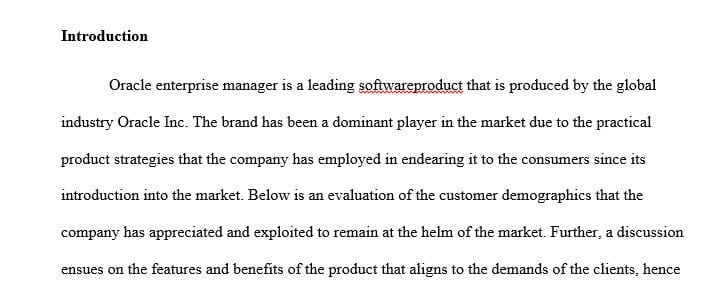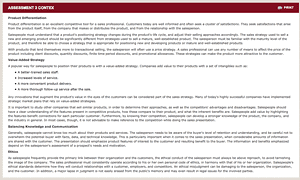Develop a product strategy that supports the presentation and sale of a product to potential customers.
Develop a product strategy that supports the presentation and sale of a product to potential customers. You will need to choose both a product and a target customer demographic, but the focus of your assessment is on how the product should be presented.
PREPARATION: product strategy
Choose and get to know a product. Decide whether you will explore a product, service, or product solution. This may be something you have sold, plan to sell, or would be interested in selling. Get to know the product thoroughly, along with how it is used (and sometimes misused) by customers. It is also important to understand how your product compares with others on the market. Not only must the salesperson be well acquainted with all product features, he or she must also be able to link each feature to a particular consumer benefit. You will also want to take into account the age and life cycle of the product for the product strategy to be effective.
Choose a target customer group. Although the customer is not your focus for this assessment, it is always best to know who you are selling to. Select a specific customer demographic, and be prepared to defend your choice. It is usually best to select a broad category, such as blue-collar neighborhoods, customers on a budget, or status-seekers.
DELIVERABLE
Begin by identifying the product, service, or product solution that you would sell, and briefly describe the customer demographic you are focusing on. Then provide the following:
Recommend key features and benefits of your product, service, or product solution, according to the needs and desires of your target audience. (Note that there is a difference between features and benefits.)
Differentiate your product from its competition. Identify close competitive products, and explain how you would differentiate your product from these, according to the expectations of your target demographic.
Compose a successful product strategy. Include a bulleted summary of key points of the product strategy that you might provide to a new sales associate who is learning about the product and situation.
Explain how your sales strategy accounts for the product’s current status in its life cycle. Is it a new or emerging product? Is it a mature and well-established product? How might this affect the way you would sell it to your target demographic?
Analyze potential opportunities for maximizing software tools in creating and executing a product strategy. What customer relationship management (CRM) software would you use, and how would you take full advantage of what it offers? Provide specific ideas about how this technology could be effective. Are there potential difficulties or concerns you might have with using this CRM?
(You may complete the requirements of this assessment in any order you wish. You do not need to follow the listed order.)
ADDITIONAL REQUIREMENTS: product strategy
Written communication is free of errors that detract from the overall message.
APA formatting: Resources and citations are formatted according to current APA style and formatting.
Number of resources: Minimum of three resources.
Length of paper: 3 to 4 typed, double-spaced pages.
Font and font size: Times New Roman, 12 point.
Answer preview to develop a product strategy that supports the presentation and sale of a product to potential customers.

831 words


